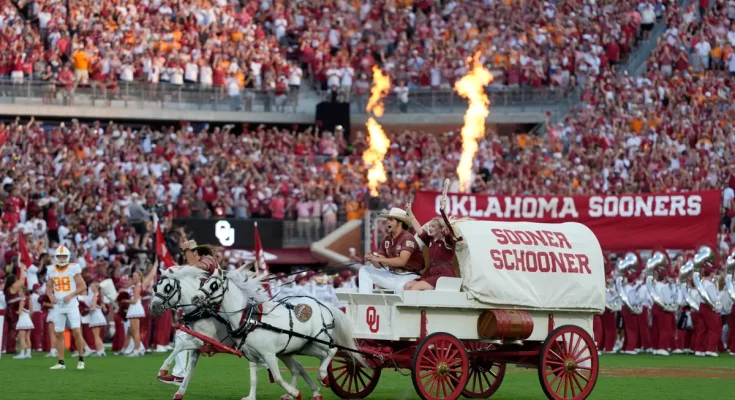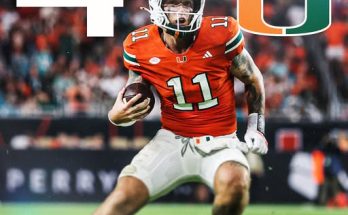“Extremely confident” may sound like a stock phrase at Big 12 Media Days, but when it comes from Oklahoma’s camp this offseason—especially regarding the offensive line—it carries a certain weight that shouldn’t be dismissed as hype. After a turbulent 2023 campaign that exposed both physical and schematic vulnerabilities up front, Oklahoma offensive line coach Bill Bedenbaugh and head coach Brent Venables are banking heavily on this group to fuel a resurgent season and restore dominance in the trenches as the Sooners transition into the SEC. If there is one unit that must become the bedrock of Oklahoma’s identity in 2024, it is without question the offensive line.
It hasn’t been a quiet offseason in Norman. Coaching changes, transfer portal movement, NIL conversations, and the endless pressure of living up to Oklahoma’s football legacy have all stirred the pot. But the Sooners haven’t run from expectations. Instead, they’ve embraced a full-scale rebuild across the offensive front with a combination of proven veterans, promising transfers, and homegrown talent who are finally stepping into leadership roles. This blend isn’t just about plugging holes; it’s about setting a tone, especially now that Oklahoma will no longer be facing Big 12 defensive lines. The SEC is a different beast entirely, and Oklahoma’s coaches know that establishing control at the line of scrimmage is a non-negotiable if the program hopes to survive and thrive.
Bill Bedenbaugh, who’s been with the Sooners for more than a decade and is regarded as one of the premier offensive line developers in the country, hasn’t sugarcoated the demands he’s placing on his group. The Sooners will need to lean on their protection to allow new quarterback Jackson Arnold to develop and make plays, but more than that, they need to re-establish a physical, punishing identity that had been missing for long stretches of the past two seasons. While OU has put plenty of offensive linemen into the NFL in the last five years, including names like Creed Humphrey and Orlando Brown Jr., the drop-off in line play has been evident since 2021. The upcoming 2024 campaign marks a pivotal moment for this group to prove they’re capable of returning to national relevance—not just as a unit that protects, but as one that dictates.
The additions Oklahoma made through the portal have made it clear that this isn’t a patience project. The Sooners didn’t wait for gradual development; they attacked the market with urgency and purpose. One of the headline acquisitions was former Michigan State offensive tackle Spencer Brown, a mammoth edge protector with over 30 career starts in the Big Ten. His experience, coupled with his SEC-caliber frame, makes him an immediate candidate to lock down the left tackle spot. Equally impactful is the arrival of Geirean Hatchett from Washington, a versatile interior lineman who brings a blend of physicality and high-level technique that has stood up to some of the best defensive fronts in the Pac-12.
These two additions, among others, have added depth, competition, and most importantly, a sense of grown-man urgency that Oklahoma desperately needed. Bedenbaugh has spoken highly of both transfers not just for their skillsets, but for the professionalism they’ve brought to the locker room. They haven’t acted like tourists. They came to work, and their presence is helping elevate the standard for everyone else. That elevation is critical when developing young linemen like Jake Taylor and Jacob Sexton, two players who were once high-profile recruits and now need to take the next step and solidify their roles as multi-year starters.
The development of Sexton in particular has been a major talking point. A 6-foot-6, 320-pound tackle with freakish athleticism for his size, Sexton showed flashes last season before an injury cut his campaign short. Now healthy, he’s being counted on to become one of the anchors of the line. With Brown likely on the left, Sexton could man the right side, giving OU legitimate bookends who can hold up in the SEC’s pass-rushing gauntlet. But nothing is given in Bedenbaugh’s system. He has preached since spring ball that roles will be earned based on consistency, not pedigree or potential. And so far, according to insiders and practice reports, that mantra has bred one of the most competitive offensive line rooms in the country.
If there’s one area where Oklahoma must improve most from 2023, it’s in short-yardage efficiency and run blocking. Too often last season, the Sooners stalled on 3rd-and-1 or failed to impose their will in four-minute situations. Despite Dillon Gabriel’s heroics at quarterback, and a deep receiver room, OU could not count on its offensive line to consistently win in the trenches when the defense knew the run was coming. That has to change. The Sooners cannot afford to be one-dimensional against SEC defenses that punish predictability. Offensive coordinator Seth Littrell, who enters his first season in the booth for OU, has emphasized balance and tempo. But even tempo doesn’t matter if you’re behind the sticks because of a two-yard loss on a run that should’ve gone for five. That’s why the line’s physicality—its ability to fire off the ball, create movement, and finish blocks—is under the microscope more than ever.
Center play is another critical piece of the puzzle. OU lost starting center Andrew Raym to the NFL, and the job is now wide open, with Troy Everett and Josh Bates competing for the starting role. Everett, a transfer from Appalachian State last season, has impressed with his cerebral approach and leadership traits, while Bates brings a raw, aggressive edge that coaches love. Whoever wins the job will be responsible not just for snapping the ball but for orchestrating protection calls, communicating with guards, and setting the tone up front. In a loud SEC environment, where crowd noise can rattle young quarterbacks, the center’s poise becomes even more crucial.
What gives Oklahoma its quiet confidence—its “extremely confident” tone—is not just the upgrades in talent, but the unity that’s being built. Bedenbaugh has emphasized that this unit, despite the new faces, has gelled faster than anticipated. That chemistry has translated to practices where the offensive line has reportedly held its own against Oklahoma’s highly-touted defensive line, which features future NFL talents like Danny Stutsman and P.J. Adebawore. In scrimmages, the line has looked cohesive, quick off the snap, and far more assignment-sound than it did last fall. These are the kinds of incremental improvements that don’t make headlines but show up in third quarters of SEC games when fatigue and toughness begin to separate contenders from pretenders.
Beyond the technical and schematic aspects, there’s a cultural urgency around the offensive line. This group has taken it personally that Oklahoma has been labeled as “not SEC ready” in the trenches. The narrative surrounding Oklahoma’s finesse-style offense and alleged soft line play has been persistent in national media, especially since the announcement of the SEC move. But inside the walls of Gaylord Family-Oklahoma Memorial Stadium, that talk is fuel. The linemen have made it clear they don’t just want to be competitive in the SEC—they want to dominate. And to do that, it starts with mindset. It’s not just about adding weight in the offseason or improving footwork. It’s about nastiness. It’s about refusing to be the reason your team loses a game. It’s about setting a standard that future classes want to match.
Veteran guard McKade Mettauer has echoed that sentiment. Entering his final collegiate season, the former Cal transfer has spoken publicly about the pressure and privilege of representing Oklahoma during this transition. He understands the gravity of the moment. The SEC will feature the likes of Georgia, Alabama, LSU, and Texas A\&M—teams with NFL-sized defensive lines and waves of pass rushers who feast on mistakes. Every play will be a test of discipline, technique, and resolve. Mettauer, Brown, Sexton, Hatchett, Bates, Everett—each lineman knows that his performance could be the difference between a playoff berth and a four-loss season.
Brent Venables hasn’t shied away from linking the offensive line’s success with the overall trajectory of the program. He’s repeatedly said that toughness, physicality, and effort in the trenches are foundational to Oklahoma football. And after two years of cultural reshaping and roster churn, Venables believes this team is closer than ever to embodying those values. His faith in Bedenbaugh and the offensive line is not just coach speak—it’s strategic. He understands that any quarterback, no matter how talented, is only as good as the protection he receives. And any run game, no matter how creative, needs daylight to be effective. This is why the offensive line is the most critical piece of Oklahoma’s potential resurgence in 2024.
There will be setbacks. That’s inevitable in a league as brutal as the SEC. But this offensive line is not built for excuses—it’s being built for answers. When the Sooners open the season and begin their gauntlet of conference play, the line will be judged not by hype or preseason predictions, but by its ability to deliver when it matters most—on 3rd-and-2, in the red zone, in the fourth quarter of a rivalry game. That’s when we’ll know whether this unit has truly turned the corner. Until then, the words “extremely confident” will hang over the program like both a promise and a challenge—one the offensive line seems ready to meet head-on.



